A pair of powerful exhibitions currently on view at the Heckscher Museum focuses on nature in all its fragile splendor while invoking the legacy of Henry David Thoreau, born 200 years ago this July. A group show, “Earth Muse: Art and the Environment,” features works by seven artists, including the East End’s own Peter Beard, Alex Ferrone, and Michelle Stuart. The works in “Earth Muse” lead the way to “Walden Revisited,” a stunning installation of large-scale vertical photographs of the trees at Walden Woods by Canadian artist Thaddeus Holownia.
Art related to the environment is a busy curatorial thoroughfare these days; it runs through several fraught neighborhoods, including politics, ethics, philosophy, geography, biology, engineering and law. The aesthetic and philosophical clarity of these two shows at the Heckscher is a tribute to the sound curatorial vision of the museum’s Director, Lisa Chalif.
Point of view is the key to understanding “Earth Muse.” Huntington artist Barbara Roux directs the gaze downward in her delicate black and white silver gelatin print of a mirror lying on the forest floor, The Earth Views the Sky. Alex Ferrone, capturing her images from a helicopter about 500 feet above the ground, raises the perspective dramatically in her boldly blue aerial view of bay and beach.
.
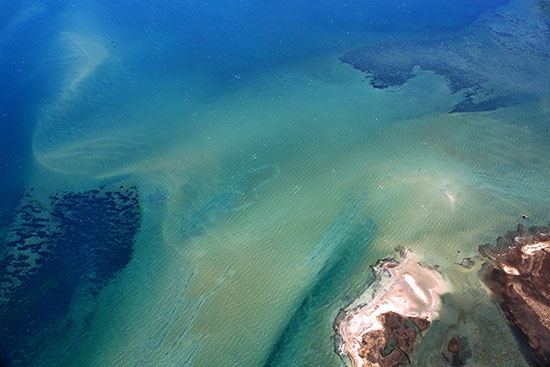
"Aerial Observations One: Palette II" by Alex Ferrone, 2013. Archival inkjet print, 27 x 37 inches. © Alex Ferrone.
.
Having followed Ferrone’s work with growing admiration through different exhibitions, I found it particularly provocative when framed by this overtly ecological theme. I usually enjoy looking at the large-scale images as I would an abstract painting, savoring the swirl of color and form estranged from the immediate recognition of where and what is represented. Here, the urgency of the message of conservation that unites the works in the show tipped Ferrone’s photography toward its documentary rather than painterly quality.
In the same section of the gallery with Roux and Ferrone, three wall reliefs from Winn Rea’s Topo Shift series of mixed media on sections of birch also exploit the aerial point of view. Rea uses U.S. Geological Survey maps of the Adirondacks, where she hikes, to build topographical models, overlaid by airbrushed renderings of the shadow forms she photographs on the forest floor. As with Ferrone’s work, these pieces deftly activate a shift in perception back and forth between two- and three-dimensional information, and between the immediacy of the footsteps in the leaves and the remoteness of the view from on high.
.
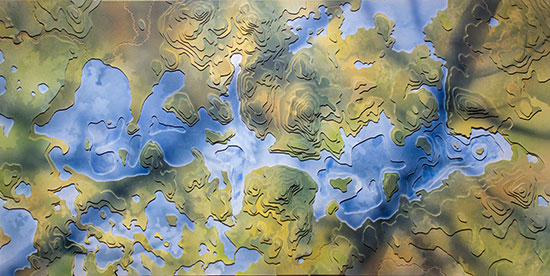
"Topo Shift: Upper Saranac" by Winn Rea, 2016. Courtesy of the Artist. Image © Winn Rea.
.
That elevated view invokes a contemplative attitude in the next section of “Earth Muse” as well, featuring the palladium photograms of ocean waves made by Melissa Fleming, a New York-based artist with a Master Naturalist Certificate from Cornell. Fleming holds her light-sensitive paper down in the water as the wave breaks and the sand and flotsam brush according to their own rhythms against the paper (one piece took a real beating, and was torn in the process).
The microcosmic individuality of the 13 works on paper from the Sea Change series, which Chalif adroitly hung in three staggered rows to invoke the ebb and surge of the water, makes the series a sepia-toned joy. They reminded me of the riveting private photographs Le Corbusier would take—for his own uses, not for gallery display—as he walked the beaches of France, focusing on the ribbed patterns of sand and water at his feet.
.
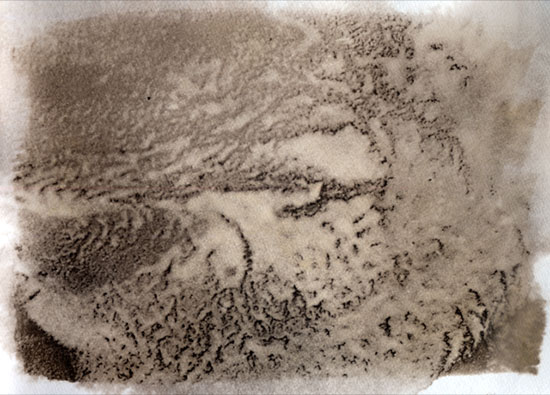
"Sea Change #15" by Melissa Fleming, 2006. Unique palladium photogram of ocean wave. Courtesy of the Artist.
.
Peter Beard is probably the biggest name in the show, and the work that he generously loaned to the museum, The Machine in the Garden, is a densely packed collage that surrounds one of his famous large platinum prints. An ominous diagonal shadow of an aircraft looms over the landscape, with the collaged tesserae of digital prints tapping the artist’s signature repertoire of African wildlife under threat from hunters.
.

"Machine in the Garden" by Peter Beard, 1972/2015. Platinum print with archival digital print collage, found object (feather), colored inks, 40 1/2 x 30 1/2 inches, UNIQUE. © Peter Beard, Courtesy Peter Beard Studio/Art + Commerce, www.peterbeard.com.
.
This piece fit perfectly next to Michelle Stuart’s square works on paper from the Codex series, that use earth from a locale at their center for an almost painterly core surrounded by C-print photographs that, like Beard’s collage, act as a colophon surrounding the central mass. The artist’s use of earth made me think of Richard Long’s use of mud on paper or the Alexis Rockman drawings made with local earth as pigment that were on view at the Parrish Art Museum in Water Mill last summer.
.
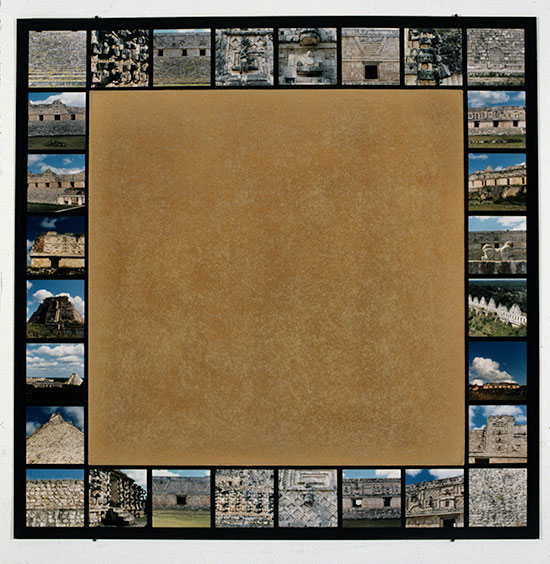
"Codex Series: Uxmal, Yucatan, Mexico" by Michelle Stuart, 1980-81. © Michelle Stuart.
.
Stuart, who has a place out in Amagansett, has been at the forefront of environmental-based art since the ’60s. I enjoyed the dialectical play between nature and human structures in Codex: Uxmal, Yucatan, Mexico, effectively taking ruminations on nature on its own into the realms of archaeology, anthropology and history. I found myself searching for the dark squares made by doors and windows as they popped into view in a staccato rhythm around the border.
The coda to the exhibition is a suite of prints that have been cut by Brandon Ballengee in a witty visual commentary confronting the problem of the loss of biodiversity to extinction. Ballengee (who is also a biologist and environmental activist) uses a print from the period when the species vanishes (for instance, an Audubon print of the sea mink, which disappeared in the 1860s), cutting out the image of the lost creature, then “cremating” the cutout and interring it in a small black urn, also on display.
Like Rea’s topographical wall reliefs, the Frameworks of Absence series relies heavily on a conceptual premise. I found it a bit daunting to see a copper plate engraving from 1682 sliced up in memory of the Jamaica Giant Galliwasp, which disappeared from this planet in the 17th century.
While it might be said that Thoreau’s lyrical meditations on nature offer an unacknowledged literary reference point for the group show, the installation of Thaddeus Howlownia’s towering portraits of the trees of Walden Woods bring Thoreau to the foreground. The 24 studies (which made me think of the 24 etudes of Chopin and set of 24 preludes and fugues of Bach’s Well-Tempered Clavier) form a grove in the final gallery of the museum. Individual trees are pulled into an intimate proximity with the viewer—with the opposite effect of those bird’s-eye view works of Ferrone and Rea in the room before.
.
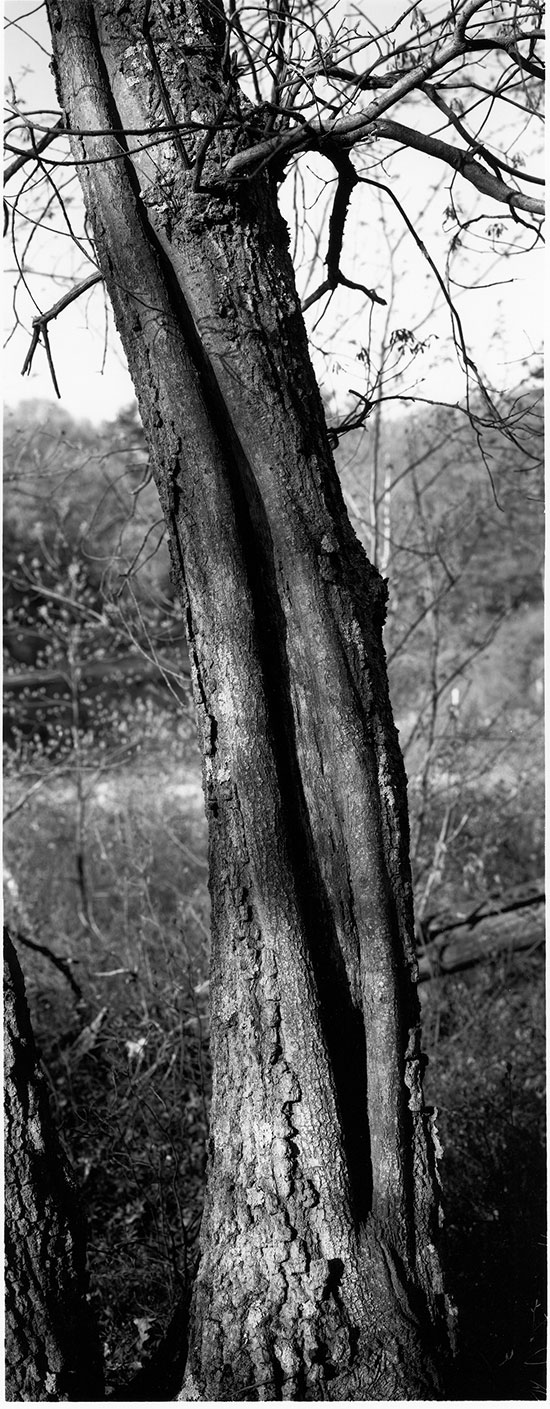
"Tree III, from Twenty-Four Tree Studies for Henry David Thoreau" by Thaddeus Holownia, 2001-2003. Courtesy of the Artist, Corkin Gallery, Toronto.
.
Holownia was born in England in 1949 and now teaches at Mount Allison University in New Brunswick. He read “Walden” as a young man, and from 2001 to 2003 replicated the two years, two months and two days that Thoreau spent by Walden Pond, hiking and photographing the site to make an uncanny connection with the place that comes through in the stunning installation.
Holownia’s work resonates with the vigorous immediacy of Thoreau’s words: “I wish to speak a word for Nature, for absolute freedom and wilderness, as contrasted with a freedom and culture merely civil, to regard man as an inhabitant, or a part and parcel of Nature, rather than a member of society … Hope and the future for me are not in lawns and cultivated fields, not in towns and cities, but in the impervious and quaking swamps.”
_____________________________
BASIC FACTS: “Earth Muse: Art and the Environment” and “Thaddeus Holownia: Walden Revisited” are on view April 15 to July 30, 2017 at the Heckscher Museum of Art, 2 Prime Avenue, Huntington NY 11743. www.heckscher.org
_____________________________
Copyright 2017 Hamptons Art Hub LLC. All rights reserved.

I had the good fortune to attend this exhibition and the Gallery Talk presented by three of the artists: Ferrone, Rea and Fleming. As a very experienced backpacker and mountaineer, my relationship to this exhibit is probably a bit different from the norm, at once more literal but tinged with a pleasant familiar intimacy. The standouts for me in this regard were the more literal works which provided for a ready connection, as with an old friend.
Ferrone’s recent exhibits have favored a broader, deeper tonal quality in her Aerial Observations which add even more depth to an already fascinating body of work. One can easily get quite lost wandering across and into the frames of these large prints. Rea’s topographic map based pieces are a living sculpture for one who speaks the language of the topographic drawing. The defining characteristic of these works for me was Rea’s break from traditional topographic modeling in which she used thin, closely trimmed layers in the altitude gradients, rather than the more typical solid layer built upon solid layer. Instead of the more common ‘mound’ depicting slope and hill, the result is a visual surge that enhances the the undulating nature of the landscape, making it feel almost like a wave frozen in time.
The real surprise, however, was Howlonia’s tree ‘portraiture’. This is one of those concepts that sounds questionable on paper, but becomes a transformative experience when assembled as a whole in a gallery as was done here. Ms. Chalif’s dedication of the surrounding wall space to this singular and deceptively simple exhibit brought the work to life. Standing in that space with these large, intimate arboreal portraits was akin to standing in a living forest, when you experience that moment that each tree is a unique living thing, complete with it’s own character and personality, conveyed by texture of bark and light.
A timely art exhibit to address the hot-button issues of climate change and conservation. Not only was it a pleasure to see the art in a quaint little museum, a mini Frick, surrounded by a lovely park, but to be reminded of great American literature was an added treat.